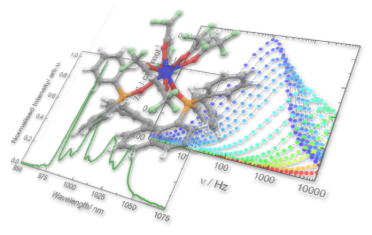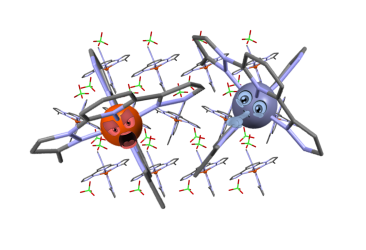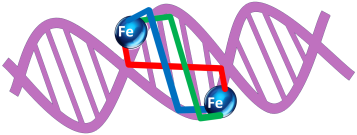
All published articles are deposited with PORTICO for archiving
Furthermore, besides the online version of the articles, offline copies are backed up.
2022
Nanotechnological approaches to address photosensitizers' limitations: towards improved clinical applicability of photodynamic therapy
Guglielmo Spinelli, Ana Belén Caballero,* Patrick Gamez
Chem. Sq., 2022, 6, 2
Luminescent and Sublimable Binaphthyl-Based Field-Induced Lanthanide Single-Molecule Magnets
Carlo Andrea Mattei, Thomas Delouche, Bertrand Lefeuvre, Marie Dallon-Cordier, Claudia Lalli, Olivier Cador, Laura Abad Galán, François Riobé,* Olivier Maury, Pierre-Antoine Bouit,* Fabrice Pointillart*
In this paper, the coordination ability of [1,1’-binaphthalene]-8,8’-diylbis(diphenylphosphine oxide) (L) with trivalent lanthanides was explored as well as both the single-molecule magnet and emissive behaviors of the sublimable mononuclear complexes [Ln(hfac)3(L)] (Ln = Eu (1), Dy (2) and Yb (3)).
Chem. Sq., 2022, 6, 1
2021
Variations to Spin Crossover in [FexZn(1−x)(Me1,3bpp)2](ClO4)2 molecular alloys examined by Magnetometry and Single Crystal X-Ray Diffraction
Rosa Diego, Olivier Roubeau, and Guillem Aromí*
An investigation of solid solutions with formula [FexZn(1-x)(Me1,3bpp)2](ClO4)2 (0 ≤ x ≤ 1; Me1,3bpp = a bis-pyrazolylpyridine) involving comprehensive powder and single crystal X-ray diffraction and magnetometry underscores the effects of the chemical negative pressure caused by Zn-for-Fe substitution within SCO alloys together with the invariance with composition of the temperature of relaxation of thermally trapped HS metastable Fe(II) ions.
Chem. Sq., 2021, 5, 1
2020
Cis and trans linkage of spin frustrated copper triangles creating Cu6 clusters
Basharat Ali, Frédéric Gendron, Xiao-Lei Li, Boris Le Guennic,* and Jinkui Tang*
Two Cu6 clusters were constructed from antiferromagnetically coupled planar triangular units in cis and trans fashion representing future potential candidates for molecular spintronics.
Chem. Sq., 2020, 4, 4
Extraction of "hidden" relaxation times from AC susceptibility data
Daniel Reta and Nicholas F. Chilton*
We explore the constraints on the intrinsic relaxation times and distributions of two distinct relaxation processes, in order for the observation of two peaks in the AC susceptibility. In the case where only one peak is observable, we also derive an expression to estimate the two underlying relaxation times, allowing extraction of “hidden” information from AC susceptibility data.
Chem. Sq., 2020, 4, 3
Coordination-enhanced photochromism in dysprosium dinuclear complexes with photomodulated single-molecule magnet behavior
Lucie Norel *, Kevin Bernot, Frédéric Gendron, Colin A. Gould, Thierry Roisnel, Stéphanie Delbaere, Boris Le Guennic, Denis Jacquemin, and Stéphane Rigaut
A pyrazine-based diarylethene ligand with fast T photochromism shows a large increase of bleaching time upon metal coordination allowing its observation and use to control properties. The effect of the isomerization on the slow relaxation of magnetization is demonstrated with the dinuclear dysprosium complex.
Chem. Sq., 2020, 4, 2
Photomagnetism in 5 nm nanocrystals of the alkali cation free-CoFe Prussian blue analogue embedded in a silica matrix
Anne Bleuzen *, Michel Goncalves, Laura Altenschmidt, Giulia Fornasieri, Amélie Bordage, Eric Rivière
This article evidences an unexpected photomagnetic effect in alkali cation free-CoFe Prussian analog nanoparticles, whose origin is discussed.
Chem. Sq., 2020, 4, 1
2019
Reversible electron transfer in organolanthanide chemistry
Arnaud Jaoul a, Maxime Tricoire a, Jules Moutet a, Marie Cordier a, Carine Clavaguéra b*, Grégory Nocton a*
Chem. Sq., 2019, 3, 1
2018
Antiproliferative properties of iron supramolecular cylinders
Rosa F. Brissos a, Luís Korrodi-Gregório b, Ricardo Péres-Tomás b, Olivier Roubeau c, Patrick Gamez a,d,e,*
Iron(III) metallohelicates were prepared from bis-β-diketone and bis-pyrazole ligands; cytotoxicity studies revealed that one of these metallocylinders exhibited interesting antiproliferative properties.
Chem. Sq., 2018, 2, 4
A triazatruxene-based molecular dyad for single-component organic solar cells
Antoine Labrunie a, Giacomo Londi b, Sergey V. Dayneko c, Martin Blais a, Sylvie Dabos-Seignon a, Gregory C. Welch a, David Beljonne b, Philippe Blanchard a,*, Clément Cabanetos a,*
The synthesis of a molecular dyad consisting of a triazatruxene-based push-pull molecule linked to a fullerene derivative is reported. The two parts were connected using the well-known copper-catalysed azide-alkyne cycloaddition (CuAAc). Encouraging power conversion efficiencies were reached embedding the active material into single-component organic solar cells.
Chem. Sq., 2018, 2, 3
A critical review of the T(LIESST) temperature in spin crossover materials − What it is and what it is not
Guillaume Chastanet a,*, Cédric Desplanches a, Chérif Baldé a,b, Patrick Rosa a, Mathieu Marchivie a, Philippe Guionneau a
This review makes a point on the good practice to measure and utilize the T(LIESST) temperature in spin crossover materials. After 20 years of use, it appeared important to detail how to measure this parameter and the information we can and cannot extract from this measurement.
Chem. Sq., 2018, 2, 2
Ligand-induced symmetry breaking, size and morphology in colloidal lead sulfide QDs: from classic to thiourea precursors
Federica Bertolotti a,b, Andrew H. Proppe c, Dmitry N. Dirin d,e, Mengxia Liu c, Oleksandr Voznyy c, Antonio Cervellino f, Simon J.L. Billinge g,h, Maksym V. Kovalenko d,e, Edward H. Sargent c, Norberto Masciocchi b,i*, Antonietta Guagliardi b,l*
A pm-scale rhombohedral distortion of the rock-salt lattice is detected in colloidal PbS QDs by forefront X-ray total scattering methods, jointly to the displacement of the Pb sublattice, as much as in the paradigmatic alpha-GeTe case. Driven by the surface ligands, the lattice distortion matches a common size-dependent law, regardless of the synthetic approach. Locally distorted ferroelectric domains show a variable degree of linear correlation.
Chem. Sq., 2018, 2, 1
2017
Ruthenium-based PACT compounds based on an N,S non-toxic ligand: a delicate balance between photoactivation and thermal stability
Jordi-Amat Cuello-Garibo a, Catriona C. James a, Maxime A. Siegler b, Sylvestre Bonnet a*
Three polypyridyl complexes with different levels of steric strain are synthesized that can photosubstitute a non-toxic aminothioether ligand. Their complex stereochemistry is characterized by a combination of spectroscopy and DFT calculations. The number of hindering groups has a crucial effect on the photochemistry and cytotoxicity of these complexes: too much strain leads to thermal activation, whereas no strain at all leads to no photoactivation in vitro. The compound with intermediate strain is a promising photoactivated chemotherapy prodrug.
Chem. Sq., 2017, 1, 2
Serving science through publishing
Guillem Aromí a, Patrick Gamez a,b, Leoní A. Barrios a, Jordi Ribas c, Boris Le Guennic d
Chem. Sq., 2017, 1, 1





























